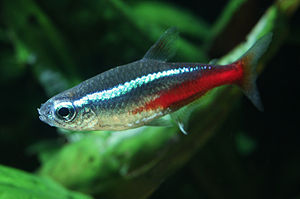Stethaprioninae
| Stethaprioninae | ||||||||||||
|---|---|---|---|---|---|---|---|---|---|---|---|---|

Neon tetra ( Paracheirodon innesi ) |
||||||||||||
| Systematics | ||||||||||||
|
||||||||||||
| Scientific name | ||||||||||||
| Stethaprioninae | ||||||||||||
| Eigenmann , 1907 |
The Stethaprioninae are a subfamily of the true tetras (Characidae). The subfamily is widespread in northern and central South America and includes most of the tetras known as aquarium fish, e.g. B. the well-known neon tetra ( Paracheirodon ) and the numerous ornamental fish from the genera Hemigrammus and Hyphessobrycon .
features
The real tetras are morphologically very conservative. It is therefore difficult to find a coherent internal system of the family. Here the system of the Argentine ichthyologist Marcos Mirande is followed, who compared 520 morphological characteristics of 259 species of tetras with each other, also used molecular-biological data and was able to determine six subfamilies and some other more or less certain monophyletic clades, to which he gave the rank of a tribe .
The Stethaprioninae include most of the tetras that have two rows of teeth on the premaxillary , typically with five teeth in the front row, the nine branched dorsal fin rays and in which the anterior branch of the sensory system on the sixth infraorbital (eye ring bones) is missing. As synapomorphies a broken line side, three or less teeth are on the maxilla and three or four unbranched fin rays with the first fins carrier joints (Pterygiophor) of the dorsal fin.
Genera
The assignment of the genera to the different tribes is not yet completely certain and could change in part after further research.
- Tribus Grundulini Fowler, 1958
- Coptobrycon Géry, 1966
- Deuterodon Eigenmann, 1907
- Erythrocharax Netto-Ferreira, Birindelli, de Sousa, Mariguela & Oliveira, 2013
- Grundulus Valenciennes, 1846
- Myxiops Zanata & Akama, 2004
- Parec base Eigenmann, 1914
- Phycocharax Ohara, Mirande & Lima, 2017
- Probolodus Eigenmann, 1911
- Stygichthys Brittan & Böhlke, 1965
- Tribus Gymnocharacini Eigenmann, 1909
- Andromakhe Terán et al., 2020
- Astyanacinus Eigenmann, 1907
- Astyanax Baird & Girard, 1854
- Ctenobrycon Eigenmann, 1908
- Gymnocharacinus Steindachner, 1903
- Oligosarcus Günther, 1864
- Psalidodon Eigenmann, 1911
- Psellogrammus Eigenmann, 1908
- Tribus Rhoadsiini Fowler, 1911Royal Tetra ( Inpaichthys kerri )
- Bario Myers, 1940
- Carlana Beach, 1928
- Hollandichthys Eigenmann, 1910
- Inpaichthys Géry & Junk, 1977
- Nematobrycon Eigenmann, 1911
- Parastremma Eigenmann, 1912
- Pseudochalceus Kner, 1863
- Rachoviscus Myers, 1926
- Rhoadsia Fowler, 1911
- Thayeria Eigenmann, 1908
- Tribus Stethaprionini Eigenmann, 1907
 Bleher's red head tetra ( Hemigrammus bleheri )
Bleher's red head tetra ( Hemigrammus bleheri ) Pristella maxillaris ( Pristella maxillary )
Pristella maxillaris ( Pristella maxillary )- Aphyodite
- Brachychalcinus Boulenger, 1892
- Brittanichthys Géry, 1965
- Bryconella Géry, 1965
- Ectrepopterus Fowler, 1943
- Gymnocorymbus Eigenmann, 1908
- Hemigrammus Gill, 1858
- Hyphessobrycon Durbin, 1908, here the Rosy Tetra species group
- Moenkhausia Eigenmann, 1903
- Nematocharax Weitzman, Menezes & Britski, 1986
- Orthospinus Reis, 1989
- Paracheirodon Géry, 1960
- Petitella Géry & Boutière, 1964
- Poptella Eigenmann, 1908
- Pristella Eigenmann, 1908
- Stethaprion Cope, 1870 (type genus)
- Stichonodon Eigenmann, 1903
Numerous genera, e.g. B. Astyanax , Hasemania , Hemigrammus , Hyphessobrycon , Jupiaba and Moenkhausia are not monophyletic and therefore further genera will be introduced in the future. The allocation of the genera is based on the allocation of the respective type species . Hasemania and Jupiaba belong to the Gymnocharacini or the Stethaprionini. The type species of the two genera have not yet been examined for classification.
supporting documents
- ↑ a b c d Mirande, JM (2018): Morphology, molecules and the phylogeny of Characidae (Teleostei, Characiformes). Cladistics, June 2018. doi: 10.1111 / cla.12345
- ↑ a b Terán, GE, Benitez, MF & Mirande, JM (2020): Opening the Trojan horse: phylogeny of Astyanax , two new genera and resurrection of Psalidodon (Teleostei: Characidae). Zoological Journal of the Linnean Society: zlaa019. April 2020. doi: 10.1093 / zoolinnean / zlaa019



